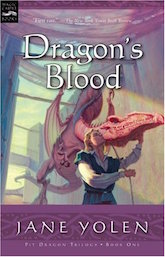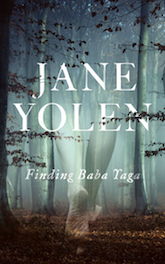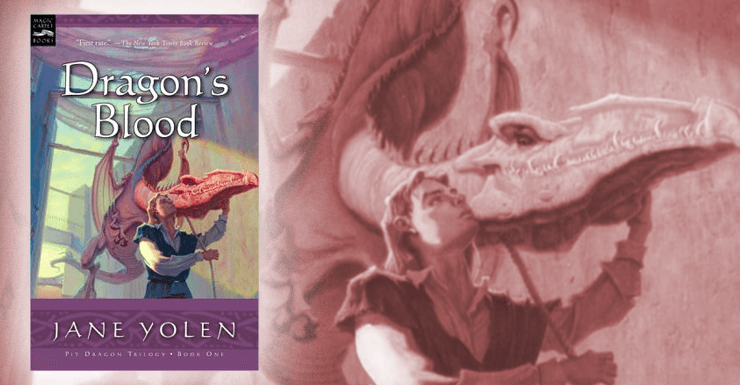At signings, people sometimes ask me which authors it is that I turn into a fanboy over. Questions like this are one of the things I love about the fantasy and science fiction community—the understanding that reader and writer are cast from the same mold. At that signing, I was the one behind the table—but at another event, I’d be the one waiting in line with my tattered book in hand, waiting to meet my favorite writers.
One of the most important people on that list for me is Jane Yolen, SFWA Grand Master and all-around awesome person. I wrote about her short story collection, The Emerald Circus, last year. (It’s awesome.) And with her releasing a new book this year, Finding Baba Yaga, Tor.com reached out to me with a question: Would I be interested in writing a post about her books?
The answer was an obvious yes, but I wanted to find a way to approach it that wasn’t simply me gushing about her work. (I’m not doing so well on that point so far, I realize.) What could I write other than, “Jane Yolen’s books are awesome, and you should read them all”?
Well, recently I’ve been thinking a lot about the first Yolen book I read: Dragon’s Blood. I encountered it during a very important point in my life, and it burned its way into my memory. It was one of the most imaginative, wonderful, and exciting things I’d ever read—but I read it years before I truly “found” my way into science fiction and fantasy fandom. (There was a personal dark age in the interim where I didn’t do a lot of reading.)
Though I often credit the books I read after this dark age for jump-starting my love of the fantasy genre, my fondness for Dragon’s Blood has lingered throughout my life. I can’t help thinking that my memories of it were what eventually prompted me to pick up those later books. It’s no coincidence that they—Dragon’s Bane by Barbara Hambly, Dragonflight by Anne McCaffrey, and Dragon Prince by Melanie Rawn—all shared a specific and obvious theme.
When I first met Jane Yolen at a convention, I had her sign a copy of Dragon’s Blood for me. It still sits proudly on my shelf with the inscription, “To Brandon: the book that did him in.” She scribbled her signature across her name in the book, which fascinated me. (If you’re wondering where I got that habit from, you can blame her.)
That said, it has been years since I read Dragon’s Blood. The last time I picked it up, I was in my 20s—before I became a writer, before I became a father, and before I published my own YA books. I found myself increasingly curious at how I’d regard it now, so I decided that it might be fun for me to do a reread and retrospective.
I narrowed my conclusions down to three general topics of interest.
Point One: Wow, I Missed a Ton
Dragon’s Blood, if you haven’t read it, is a quintessential “boy and his dragon” story. It shares a lot of elements with more recent works like How to Train your Dragon or Eragon, but also with other classics from the past, like McCaffrey’s The White Dragon. I’ve always been a sucker for this sort of story, and consider it one of my favorite archetypes in the genre.
But Yolen is well known for her thematic subtexts—and boy, this book digs into some heavy concepts. She does it in classic Jane Yolen fashion, by integrating them deeply into the setting and characters. Her stories tend not to feel like parables or polemics; she explores the things that make us human—and serves them up raw, exposed, and sometimes in an uncomfortable manner.
Buy the Book


Dragon’s Blood
Dragon’s Blood is a far future story about humans living on far off colonies on distant planets. There is wonder in this—we’ve explored the stars, and on one of the planets we found dragons! Yet the young male main character, Jakkin, is a slave who lives in a setting that has relatively little access to futuristic technology. The planet’s environment is harsh, with temperatures at night that will kill a human exposed to them. But the characters have no access to environmental suits or even simple hand warmers. The people are expected to be indoors at night, or end up freezing.
Most of the characters, including both the male and female protagonists, are bond slaves—required to wear bags that hang around their necks and fill them with coins to earn their freedom. There is a pervasive, if subtle, undercurrent of women being pressed into the sex trade as a means of filling their bags. (A life that at least one character indicates was difficult to escape without external help.)
The implication is that traveling the stars cost so many resources, and was so difficult, that these distant colonies are left basically to fend for themselves. And a lot of the social progress and rights we take for granted even in our lives now are not present for these distant scions of our culture. The book presents a subtle Lord of the Flies-type problem—if we were pushed into a harsh environment, would we too find our way to something that feels medieval in a lot of its attributes? While a lot of science fiction of the period presents its “frontier colony” attitude with a glimmer and shine, this book flips the coin to reveal the tarnish on the other side.
For example, the dragons have a magical wonder to them, but are presented as beasts trained to fight for prizes. They’re farmed and treated like property—and although they display an unearthly intelligence, they are a primary source of meat for the colonists. Everyone in the book seems to recognize how sad this is, but their survival depends on it. Even Jakkin, while talking about the beauty of dragons, is planning to take his stolen hatchling and teach it to fight (possibly to the death) to earn gold to free himself.
It’s a beautiful, tragic clash between necessities and ideals, presented in a brutal fashion. The story isn’t just saying, “Look how terrible this is.” It’s saying, “This is what human beings do to survive—and it’s often ugly.”
The ten-year-old me sensed some of this. I had wondered why this story wasn’t simply about how wonderful it would be to have your own dragon—and why I had to also read about dragons dying, becoming stew for humans. But I’m now confident that this complicated nuance in the book is a large part of what made it stick with me.
Point Two: It’s Very Real
I’m intrigued by how well Yolen walks the line between telling a good story and keeping the story real. Dragon’s Blood, contrary to my expectations when approaching it as an adult, doesn’t feel pulp at any point. (With pulp being defined here as over-the-top action or emotion.)
I have nothing against a few pulp moments in a story; I tend to revel in them. Yet this story manages to present a gritty take on a boy raising a dragon. There’s a scene where Jakkin goes out on a hunt to kill oversized pests that can be dangerous to dragon hatchlings. His nervousness culminates in an almost anti-action scene where he is lost in the confusion, and eventually stabs one of the creatures—but only after it’s been killed by someone else.
The primary female protagonist, Akki, has some makings of the hidden princess trope. (She’s secretly the daughter of the lord who owns Jakkin and the others.) And yet, while a similar book might use this reveal to put her on some kind of pedestal, Dragon’s Blood uses it to dig into the scars she bears, making a careful and calculated use of this trope for a reversal later in the book—where Akki is presented as a character who is not a foil for Jakkin’s story, nor a prize for his reward, but simply someone living her own story.
Much about the book, but especially about the ending, feels so very genuine. The story doesn’t revel in how wonderful, heroic, or exceptional either of the main characters is. Rather, it presents them as people. This book was released in 1982, when fantasy was really ramping up the idea of destined saviors. While these stories have their own charm, I like how grounded Dragon’s Blood remains.
The ten-year-old me latched on to Jakkin specifically because of his authenticity. Reading it now, I’m surprised at how brief and traumatic the action scenes are. This book expends its words on keeping this outlandish story of future dragons intimate and personal.
This isn’t a story about some grand quest, or even—despite the setup—the story of a lowly slave getting vengeance. It’s a story about people living in a harsh environment, doing what they can to survive, and struggling with the society they’ve created. (Or inherited.) It is a story that resists the call of the obvious at every turn, and in so doing creates something unexpected in the best of ways.
Point Three: It’s Still a Blast
Dragon’s Blood is grounded, and it provides very interesting commentary—but it doesn’t disappoint. This is a story about a young man raising his own dragon, and it was an extremely engaging read.
I’m always hesitant to approach a story I loved when I was young. I don’t think my adult eyes “ruin” stories, really. (Well, with a few exceptions.) I can still generally appreciate a story I loved when I was young simply because of what it did for me at that age—but there are certain stories I just want to leave with that youthful impression.
Buy the Book


Finding Baba Yaga: A Short Novel in Verse
I suspected this wouldn’t be the case with Dragon’s Blood because I have read so much of Yolen’s writing—but I was gratified by how well the story still works for me. Generally, the stories that appeal to both the young Brandon and the old(er) Brandon have layers of engagement. And Yolen’s writing, line by line, continues to be a delightful thing to experience.
But to really love rereading something as an adult, I do need to be able to glimpse the raw excitement that gripped me as a youth. As I reread this book, I found myself absorbed in it as I was some thirty years ago.
Dragon’s Blood is meant to be fun, and it is fun. In some ways, approaching it as realistically as Yolen did is a means of letting us have that fun. Some stories say, “It’s okay, you can turn your brain off and just enjoy this.” But Jane Yolen’s work says something different. It says, “You don’t have to turn anything off. Think about this. Worry about it. But accept it as part of a story that it’s all right to enjoy at the same time.” I think that’s a balance the best works of science fiction and fantasy strive to achieve.
There’s an innate sense of story momentum as Jakkin’s dragon grows. There’s mystery and tension as he and Akki work to keep it hidden. And there’s that overriding question: Will Jakkin succeed in winning his freedom? What will it cost for him to do so? The book is short—I listened to the audio edition this time around, and it took roughly six hours. But it packs a lot into that time, and I found the experience to be an absolute pleasure.
I’m very glad I dug back into Dragon’s Blood. The experience both reminded me of my own first fledgling steps as a reader and also taught me a thing or two about storytelling.
 Brandon Sanderson is the author of various bestselling works such as the Stormlight Archive and Mistborn. His newest YA book, Skyward, is based off his love of the classic dragon egg stories—only with spaceships and flight school instead. Read the sample chapters here!
Brandon Sanderson is the author of various bestselling works such as the Stormlight Archive and Mistborn. His newest YA book, Skyward, is based off his love of the classic dragon egg stories—only with spaceships and flight school instead. Read the sample chapters here!










